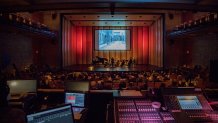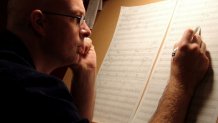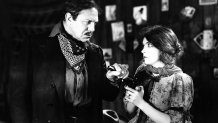At the Dallas Chamber Symphony, there is nothing quiet about silent films. As a part of its UnSilent Film Series, the orchestra commissions new scores for silent films and debuts the score with a concert screening of the film.
The orchestra continues this popular series with "The Wind," the 1928 romantic drama set in Sweetwater, Texas starring Lillian Gish, on November 23 at the Moody Performance Hall in the Dallas Arts District.

Richard McKay, the orchestra's artistic director and conductor, turned to Alain Mayrand to compose a new score for the 90-minute movie. Mayrand has worked with the orchestra before, creating a score for the Harold Lloyd film, "Ask Father." The Canadian composer has worked on blockbusters "Ender's Game," "Elysium," as well "What Happened to Monday," "Dead Snow II" and the TV series "Olympus." He plays the piano, cello, flute, classical and electric guitar and recently composed the orchestral music for the high-profile Olympic Ring Ceremony in Montreal. Mayrand talks about his process and the distinctive challenges of composing for a silent film.
NBCDFW: You play several instruments. Did you play all of these instruments before you began composing or did you learn more instruments as you took on more composing projects?
Alain Mayrand: I learned guitar and piano from a young age and that is what led me to writing music. Once I started studying composition in university there was orchestration, of course! I wanted to improve my orchestral writing beyond the orchestral textbooks and so I learned flute, cello and percussion for that reason. I achieved a good intermediate level on each and it helped my writing tremendously.
NBCDFW: What led you to composing for film and television?
Local
The latest news from around North Texas.
AM: I had an interest in films and film music from a very young age, starting around the age of 6 or 7 years old. I would listen to records and I would tape film music off the television onto cassette tapes. My interest always leaned towards film more than television even then.
My decision to become a composer came gradually. It was through rock and jazz that I found my way to concert music, and once I heard "The Rite of Spring," it sealed my fate and I knew I wanted to compose for the orchestra.
But oddly enough, even though film music was my first musical interest, it never occurred to me to become a film composer until I took a class in it during my master's degree. It was like an epiphany really once I started doing it.
I still wanted to write concert music however, but once I graduated, I also tried my hand at film scoring as I pursued my career as a concert composer. As time went on, I had some success as a concert composer, was composer-in-residence with a local orchestra but found myself drawn to the workman-like aspect of film scoring and veered more and more in that direction until it became my main focus.
And now, I have gone full circle back to my first musical love as a child: film music!
NBCDFW: You have composed for several genres - drama, action, animation. Do these genres come with distinct challenges? Does music play a different role in these different genres?

AM: At the core, the story is what matters and that foundation is in many ways always the same. However, some stories are harder to crack than others!
Musically they are, of course, quite different. Dramas are often the easiest musically and technically, with less music to write, often less musical complexity, fewer notes and not many on-screen actions to follow. The role of the music is often much more story-related, telling some aspect of the subtext that gives information to the audience. That is a lot of fun to capture and means the music is a huge part of the storytelling, which is of course a challenge.
Animation and action are often easier to capture the tone of, it's more obvious in terms of story, but technically is more demanding, with many more notes and on-screen actions to highlight with the music. The role of the music is more obvious generally with these genres, the music often serving the function of highlighting surface elements and less subtext.
But I try to bring as much storytelling to every genre and not simply point out something that is obvious with the music. That is much more fun and satisfying and, in the end, better for the film.
NBCDFW: How is composing a score for a silent film different than a modern film?
AM: Composing for a silent film is different in three major ways I'd say.
The first obvious difference is that the music in a silent film plays without stopping and takes center stage having no dialogue or sound effects to share audio space with. This means the music has to do all the heavy lifting in a silent film, while in modern films that is not the case.
Secondly, the style of the music is an important difference. It would not work composing a silent film score using the current modern style as it would clash with the visuals. The music has to echo the style of the period, I believe. However, that is something I tried to navigate with some degree of latitude when scoring "The Wind," using some period style music while contrasting it with other musical styles and inspirations, even going atonal for a moment or two!
Lastly, a very important difference with this concert performance of "The Wind" is the fact that it is just that; a concert performance. A film score is recorded in small sections using a metronome (or "click") to keep time, but this live performance is done in a continuous 73-minute stream of music done without any "click" to help the conductor and musicians time themselves to picture. All timings are done only using visual aids that will guide the conductor and that nobody else will see.
This makes a big difference when composing as you have to create musical ideas and phrases that allow an ease in timing to the picture, something that is of lesser importance when done in the studio for regular film recording.

NBCDFW: What do you admire about "The Wind?" Is there anything that surprised you about the film?
AM: "The Wind" is a dramatic film that still sucks you into its story even without sound. I think Lillian Gish is outstanding in the main role in this film. The intensity of her gaze as the wind slowly affects her was very inspiring and guided me in my musical telling of this story.
I also felt there were some wonderful visual moments using various camera and editing techniques that didn't feel trite at all to my modern eyes and really helped convey the mood and story.
As I worked my way through the score (which I scored chronologically), I found myself getting more and more attached to the plight of Letty, the main character played by Lillian Gish, and when the time came to score the dénouement or ending of the story, I felt a real joy and satisfaction which I think can only come from a solidly told story.
NBCDFW: Which is harder: composing a score for a silent film or composing orchestral music for the Olympic Ring Ceremony for the Canadian Olympic Committee? And how did you get the Olympic assignment?
AM: I received this commission through a company I had worked with before who was in charge of the visuals for this event and we worked together on creating the whole presentation as the music came first and guided the visuals.
With "The Wind" I followed what I saw on the screen but the COC commission required me to imagine the visuals ahead of time based on a brief and plan them out on a timeline that I then composed to. I felt like I had a lot of responsibility on my shoulders since my music was the guide for the visuals. So, for that reason, I would say the COC commission was more difficult as a whole.
However, "The Wind" uses a chamber ensemble and not a regular orchestra. The chamber group poses unique problems of balance and projection and really does affect what I was able to write. In those terms "The Wind" was the more challenging of the two.
MORE: DCSymphony.org



